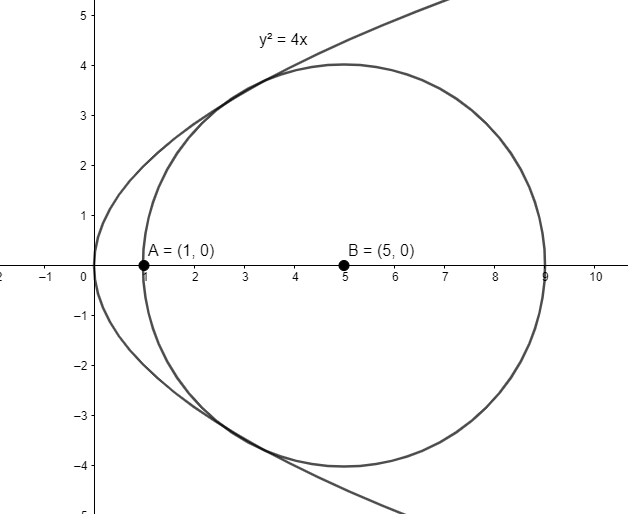
Radius of the largest circle which passes through the focus of the parabola ${{y}^{2}}=4x $ and contained in it, is
(a). 8
(b). 4
(c). 2
(d). 5
Answer
218.4k+ views
Hint: To find the radius of the largest circle which passes through the focus of the parabola and is contained in the parabola, we will find the centre of the parabola by making the general equation of circle pass through the focus of the parabola and solve it in terms of radius of the circle.
Complete step by step answer:
We have the equation of parabola as ${{y}^{2}}=4x $.
We want to find the radius of the largest circle which passes through the focus of the parabola.
We know the focus of the parabola of the form \[{{y}^{2}}=4ax\] is \[(a,0)\] .
Thus, the focus of the parabola \[{{y}^{2}}=4x\] is \[(1,0)\] .

As we want the largest circle contained in parabola \[{{y}^{2}}=4x\] and the circle passes through focus of parabola, the centre of the circle lies on \[x\] -axis.
Let’s assume that the centre of the circle is \[(h,0)\] .
Let the radius of the circle be \[r\] .
As the circle passes through \[(1,0)\] , we have \[h=1+r\] . \[(1)\]
We know the equation of circle passing through the point \[(h,k)\] is of the form \[{{(x-h)}^{2}}+{{(y-k)}^{2}}={{r}^{2}}\] .
So, the equation of our circle is \[{{(x-h)}^{2}}+{{y}^{2}}={{r}^{2}}\]
Substituting the value of \[h\] from equation \[(1)\] , we get \[{{(x-1-r)}^{2}}+{{y}^{2}}={{r}^{2}}\] .
\[\Rightarrow {{x}^{2}}+{{r}^{2}}+1-2x-2xr+2r+{{y}^{2}}={{r}^{2}}\]
\[\Rightarrow {{x}^{2}}+{{y}^{2}}-2x-2xr+1+2r=0\]
But, we know \[{{y}^{2}}=4x\] . Substituting this in the above equation, we get \[{{x}^{2}}+4x-2x-2xr+1+2r=0\] .
\[\Rightarrow {{x}^{2}}+2x-2xr+1+2r=0\] \[(2)\]
The above quadratic equation will have equal roots because the circle intersects the parabola.
We know that when the quadratic equation of the form \[a{{x}^{2}}+bx+c=0\] has equal roots, we have \[{{b}^{2}}-4ac=0\] .
Substituting \[b=2-2r,c=1+2r\] from equation \[(2)\] to the above formula, we get \[{{(2-2r)}^{2}}=4(1+2r)\] .
On further solving this equation, we get
\[\begin{align}
& \Rightarrow 4+4{{r}^{2}}-8r=4+8r \\
& \Rightarrow 4{{r}^{2}}-16r=0 \\
& \Rightarrow 4r(r-4)=0 \\
& \Rightarrow r=0,r=4 \\
\end{align}\]
But the radius of the circle can’t be 0, so, the required answer is \[r=4\] .
Hence, the correct answer is 4.
Note: We can’t solve the question without the fact that the circle passes through the focus of the parabola and touches the parabola at some point. Also, one must know that a circle with 0 radius is just a point.
Complete step by step answer:
We have the equation of parabola as ${{y}^{2}}=4x $.
We want to find the radius of the largest circle which passes through the focus of the parabola.
We know the focus of the parabola of the form \[{{y}^{2}}=4ax\] is \[(a,0)\] .
Thus, the focus of the parabola \[{{y}^{2}}=4x\] is \[(1,0)\] .

As we want the largest circle contained in parabola \[{{y}^{2}}=4x\] and the circle passes through focus of parabola, the centre of the circle lies on \[x\] -axis.
Let’s assume that the centre of the circle is \[(h,0)\] .
Let the radius of the circle be \[r\] .
As the circle passes through \[(1,0)\] , we have \[h=1+r\] . \[(1)\]
We know the equation of circle passing through the point \[(h,k)\] is of the form \[{{(x-h)}^{2}}+{{(y-k)}^{2}}={{r}^{2}}\] .
So, the equation of our circle is \[{{(x-h)}^{2}}+{{y}^{2}}={{r}^{2}}\]
Substituting the value of \[h\] from equation \[(1)\] , we get \[{{(x-1-r)}^{2}}+{{y}^{2}}={{r}^{2}}\] .
\[\Rightarrow {{x}^{2}}+{{r}^{2}}+1-2x-2xr+2r+{{y}^{2}}={{r}^{2}}\]
\[\Rightarrow {{x}^{2}}+{{y}^{2}}-2x-2xr+1+2r=0\]
But, we know \[{{y}^{2}}=4x\] . Substituting this in the above equation, we get \[{{x}^{2}}+4x-2x-2xr+1+2r=0\] .
\[\Rightarrow {{x}^{2}}+2x-2xr+1+2r=0\] \[(2)\]
The above quadratic equation will have equal roots because the circle intersects the parabola.
We know that when the quadratic equation of the form \[a{{x}^{2}}+bx+c=0\] has equal roots, we have \[{{b}^{2}}-4ac=0\] .
Substituting \[b=2-2r,c=1+2r\] from equation \[(2)\] to the above formula, we get \[{{(2-2r)}^{2}}=4(1+2r)\] .
On further solving this equation, we get
\[\begin{align}
& \Rightarrow 4+4{{r}^{2}}-8r=4+8r \\
& \Rightarrow 4{{r}^{2}}-16r=0 \\
& \Rightarrow 4r(r-4)=0 \\
& \Rightarrow r=0,r=4 \\
\end{align}\]
But the radius of the circle can’t be 0, so, the required answer is \[r=4\] .
Hence, the correct answer is 4.
Note: We can’t solve the question without the fact that the circle passes through the focus of the parabola and touches the parabola at some point. Also, one must know that a circle with 0 radius is just a point.
Recently Updated Pages
The maximum number of equivalence relations on the-class-11-maths-JEE_Main

A train is going from London to Cambridge stops at class 11 maths JEE_Main

Find the reminder when 798 is divided by 5 class 11 maths JEE_Main

An aeroplane left 50 minutes later than its schedu-class-11-maths-JEE_Main

A man on the top of a vertical observation tower o-class-11-maths-JEE_Main

In an election there are 8 candidates out of which class 11 maths JEE_Main

Trending doubts
JEE Main 2026: Application Form Open, Exam Dates, Syllabus, Eligibility & Question Papers

Derivation of Equation of Trajectory Explained for Students

Hybridisation in Chemistry – Concept, Types & Applications

Understanding the Angle of Deviation in a Prism

Understanding Collisions: Types and Examples for Students

Understanding Atomic Structure for Beginners

Other Pages
JEE Advanced Marks vs Ranks 2025: Understanding Category-wise Qualifying Marks and Previous Year Cut-offs

NCERT Solutions for Class 11 Maths Chapter 10 Conic Sections

NCERT Solutions for Class 11 Maths Chapter 9 Straight Lines

NCERT Solutions For Class 11 Maths Chapter 8 Sequences And Series

How to Convert a Galvanometer into an Ammeter or Voltmeter

NCERT Solutions For Class 11 Maths Chapter 12 Limits And Derivatives




